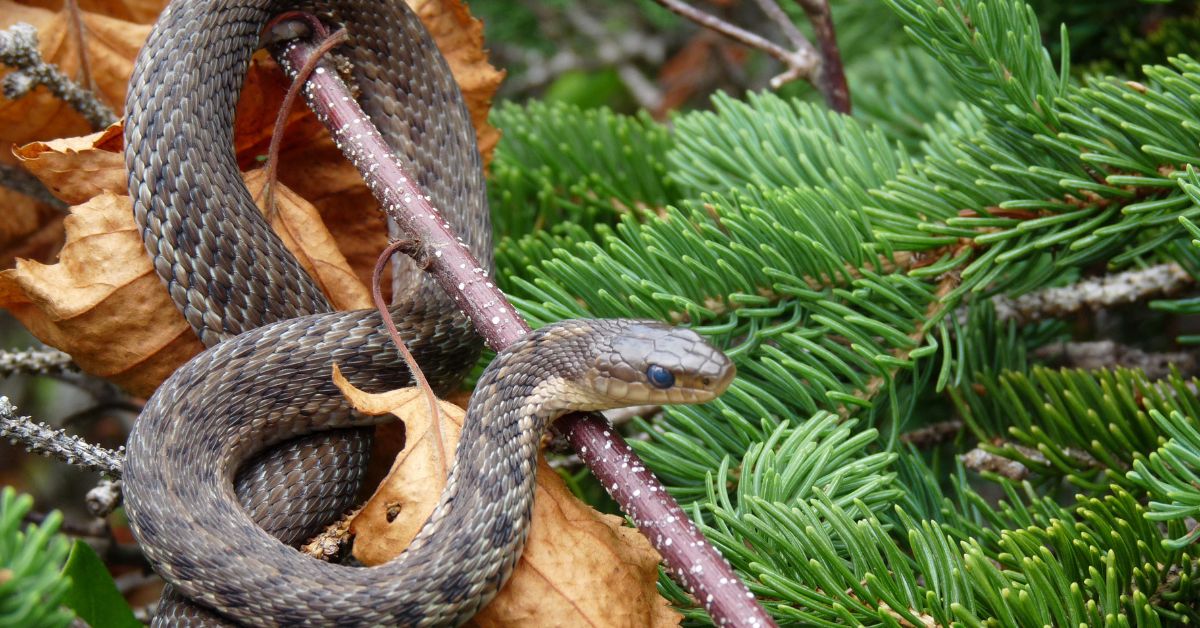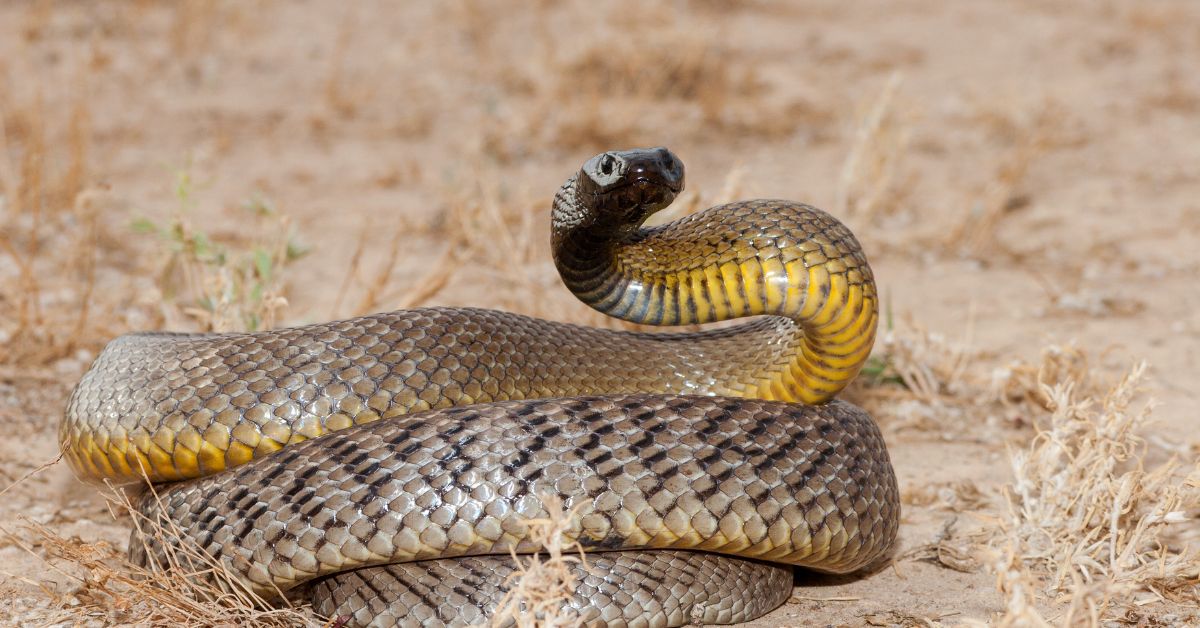The diverse array of wildlife on our planet is both captivating and, at times, perilous. As we explore the natural world, we encounter creatures armed with potent venoms capable of inflicting serious harm or even death.
In this blog post, we embark on a journey to uncover the top 10 most poisonous animals in the world, from the venomous fangs of the Inland Taipan to the deceptively beautiful hues of the Blue Poison Dart Frog.
Each of these creatures possesses a deadly arsenal, underscoring the importance of understanding and respecting the power wielded by these fascinating yet perilous inhabitants of our planet.
Top 10 Most Poisonous Animals in the World
1. Inland Taipan
The Inland Taipan, often referred to as the “fierce snake,” holds the title of the world’s most venomous snake. Inhabiting the arid regions of Australia, this serpent’s venom is a potent cocktail of neurotoxins, capable of causing paralysis and respiratory failure.
Despite its fearsome reputation, the Inland Taipan is reclusive, avoiding human encounters whenever possible. The adaptation of its venom serves as a testament to the evolutionary arms race between predators and prey, highlighting the intricate balance within ecosystems that feature such formidable creatures.
While bites are exceptionally rare, the Inland Taipan remains a captivating and potentially deadly inhabitant of the Australian outback.
2. Box Jellyfish
The Box Jellyfish, often dubbed the “world’s most venomous marine creature,” drifts silently through the waters of the Indo-Pacific, its nearly transparent bell concealing a lethal payload.

Armed with tentacles lined with stinging cells, this gelatinous creature delivers venom capable of inducing cardiac arrest and respiratory failure.
The term “poisonous animals” takes on a literal meaning in the context of encounters with the Box Jellyfish, as its venom underscores the dangers that lurk beneath the ocean’s surface.
To mitigate the risk, swimmers in regions populated by Box Jellyfish must take precautions, wearing protective swimwear and remaining vigilant in the presence of this nearly invisible aquatic menace.
3. Blue-ringed Octopus
In the vast expanse of the Pacific and Indian Oceans, the Blue-ringed Octopus, despite its diminutive size, is a creature to be approached with extreme caution. Possessing vibrant blue rings that serve as a warning to potential predators, this cephalopod packs a venomous punch.

The saliva of the Blue-ringed Octopus contains potent neurotoxins capable of causing paralysis and respiratory failure in its prey. For humans, an encounter with this tiny terror can be deadly.
The vivid appearance of this marine marvel serves as a visual representation of the dangers associated with the world’s most poisonous animals, emphasizing the need for respect and understanding when navigating the oceans’ depths.
4. Stonefish
Beneath the waves of the Indo-Pacific region, the Stonefish lurks, a true master of underwater camouflage. Disguised as a rock or coral, this venomous fish awaits unsuspecting prey, utilizing its dorsal fin spines to inject a potent venom.

The term “poisonous animals” finds a literal embodiment in the Stonefish, whose venom causes intense pain, tissue necrosis, and, in severe cases, death.
The Stonefish’s ability to blend seamlessly into its surroundings underscores the evolutionary adaptations that have allowed it to become a formidable predator, reinforcing the notion that danger can often be found where it is least expected.
5. Cone Snails
Beneath the ocean’s surface, the Cone Snails showcase a deceptive elegance that belies their lethal nature. These marine snails, found in tropical waters, possess harpoon-like teeth that inject venom capable of causing paralysis and, in some instances, proving fatal to humans.

The intricacies of their patterned shells and the allure of their underwater habitats draw attention to the delicate balance that exists in marine ecosystems, where even the most beautiful creatures can harbor deadly secrets.
The presence of Cone Snails serves as a reminder that beneath the ocean’s serene façade lies a world where the term “poisonous animals” takes on a very real and dangerous significance.
6. Inland Australian Taipan
Similar to its coastal relative, the Inland Australian Taipan is a highly venomous snake inhabiting the arid regions of Australia. While bites from this serpent are extremely rare, the neurotoxic venom it delivers is swift and potent.

As one of the world’s most poisonous animals, the Inland Australian Taipan represents an essential component of Australia’s diverse ecosystem.
The evolutionary adaptations that have allowed it to thrive in challenging environments also underscore the need for caution and respect when navigating the natural landscapes that these formidable creatures call home.
7. Deathstalker Scorpion
In the arid landscapes of North Africa and the Middle East, the Deathstalker Scorpion roams, its small size belying its lethal potential. Armed with venom containing neurotoxins, this scorpion delivers a sting that induces intense pain and, in extreme cases, can be fatal.

The Deathstalker Scorpion exemplifies the concept of “poisonous animals” in its most literal sense, emphasizing the importance of understanding and respecting the wildlife inhabiting diverse ecosystems worldwide.
8. Marbled Cone Snail
Residing in coral reefs of the Indo-Pacific, the Marbled Cone Snail exudes an aura of deadly elegance. The intricate patterns on its shell and the vibrant hues that adorn its exterior mask the harpoon-like tooth capable of delivering venom that can lead to respiratory failure.

The apparent contradiction between the snail’s beauty and its lethal capabilities serves as a poignant reminder that the world’s most poisonous animals often reside in habitats that demand careful exploration and a profound understanding of the potential dangers lurking beneath the surface.
9. Blue Poison Dart Frog
In the lush rainforests of Central and South America, the Blue Poison Dart Frog showcases its vibrant colors, providing a stark warning to potential predators.
Despite its diminutive size, this amphibian secretes potent alkaloid toxins through its skin, a defense mechanism developed through evolutionary processes.
The concept of “poisonous animals” takes a visually stunning form in the Blue Poison Dart Frog, underscoring the intricate relationship between appearance and defense mechanisms in the natural world.
10. Brazilian Wandering Spider
Among the foliage of South American forests, the Brazilian Wandering Spider creeps silently, its bite delivering venom that induces severe pain, muscle spasms, and, in certain cases, priapism.

While rarely fatal to humans, encounters with this arachnid highlight the need for caution in regions where such dangerous creatures roam.
The Brazilian Wandering Spider personifies the concept of “poisonous animals” on land, emphasizing the importance of awareness and understanding when navigating diverse ecosystems that house potentially lethal inhabitants.
Frequently Asked Questions
[sc_fs_multi_faq headline-0=”h4″ question-0=” What is the most poisonous animal in the world?” answer-0=”The most poisonous animal in the world is the golden poison dart frog (Phyllobates terribilis). Native to Colombia, this small frog’s skin secretes a potent neurotoxin called batrachotoxin, which is deadly to predators and can even be fatal to humans.” image-0=”” headline-1=”h4″ question-1=”Are there any antidotes for the venom of the world’s most poisonous animals?” answer-1=”Yes, many venomous animal bites or stings have specific antidotes or treatments available. For example, antivenom is commonly used for snake bites, scorpion stings, and spider bites. However, the availability of antidotes may vary depending on the region, and prompt medical attention is crucial to administering the appropriate treatment.” image-1=”” headline-2=”h4″ question-2=”What does the Marbled Cone Snail eat?” answer-2=”The Marbled Cone Snail primarily preys on small fish, worms, and other marine mollusks. It uses its venomous harpoon to immobilize and subdue its prey before engulfing it whole.” image-2=”” headline-3=”h4″ question-3=”Are Marbled Cone Snails found in captivity?” answer-3=”Some Marbled Cone Snails can be found in captivity, but they are not commonly kept as pets due to their dangerous nature. Snail enthusiasts and specialized aquariums with the expertise to handle venomous creatures may keep them under controlled conditions.” image-3=”” headline-4=”h4″ question-4=”What does the Deathstalker Scorpion eat?” answer-4=”The Deathstalker Scorpion is a carnivorous arachnid that primarily preys on insects, spiders, and other small creatures. It uses its venom to immobilize and digest its prey” image-4=”” headline-5=”h4″ question-5=”Are Deathstalker Scorpions commonly kept as pets?” answer-5=”While some people do keep Deathstalker Scorpions as pets, they require specialized care and handling due to their venomous nature. It is not recommended for inexperienced keepers or households with children or pets” image-5=”” headline-6=”h4″ question-6=” How dangerous is the Inland Australian Taipan’s venom?” answer-6=”The venom of the Inland Australian Taipan is incredibly potent and can be fatal to humans if bitten. However, the snake is quite reclusive and rarely encountered, which significantly reduces the risk of bites.” image-6=”” headline-7=”h4″ question-7=”What does the Inland Australian Taipan eat?” answer-7=”The Taipan primarily preys on small mammals, such as rodents, which constitute the bulk of its diet. It uses its venom to immobilize its prey before swallowing it whole.” image-7=”” headline-8=”h4″ question-8=”What do Cone Snails eat?” answer-8=”Cone Snails are carnivorous and feed primarily on other marine creatures. They use a specialized proboscis to harpoon and inject venom into their prey, immobilizing them before consuming their soft tissues.” image-8=”” headline-9=”h4″ question-9=”Can Cone Snails be kept as pets?” answer-9=”Cone Snails are not suitable pets for the average aquarium hobbyist due to their venomous nature. Keeping them in captivity requires expertise in handling venomous animals and providing appropriate living conditions.” image-9=”” headline-10=”h4″ question-10=”How dangerous is the Stonefish’s venom?” answer-10=”The Stonefish possesses venomous spines on its dorsal fin, which can cause excruciating pain, swelling, and tissue damage if stepped on or accidentally touched. In extreme cases, the venom can be life-threatening, especially if not treated promptly.” image-10=”” headline-11=”h4″ question-11=”How can one avoid being stung by a Box Jellyfish?” answer-11=”To avoid Box Jellyfish stings, it’s important to be cautious when swimming in waters where they are known to inhabit. Wearing protective clothing such as rash guards or stinger suits and paying attention to warning signs on beaches can help reduce the risk of encounters.” image-11=”” headline-12=”h4″ question-12=”How can one identify a Blue-ringed Octopus?” answer-12=”Blue-ringed Octopuses get their name from the bright blue rings that appear on their skin when they feel threatened or agitated. These rings serve as a warning sign to potential predators and should be a clear indication for humans to keep their distance.” image-12=”” headline-13=”h4″ question-13=”How aggressive is the Inland Taipan towards humans?” answer-13=”The Inland Taipan is shy and elusive by nature and will generally avoid encounters with humans. It will only bite if it feels threatened or cornered.” image-13=”” count=”14″ html=”true” css_class=””]
Recommended
Top 10 Loudest Animals on Earth


